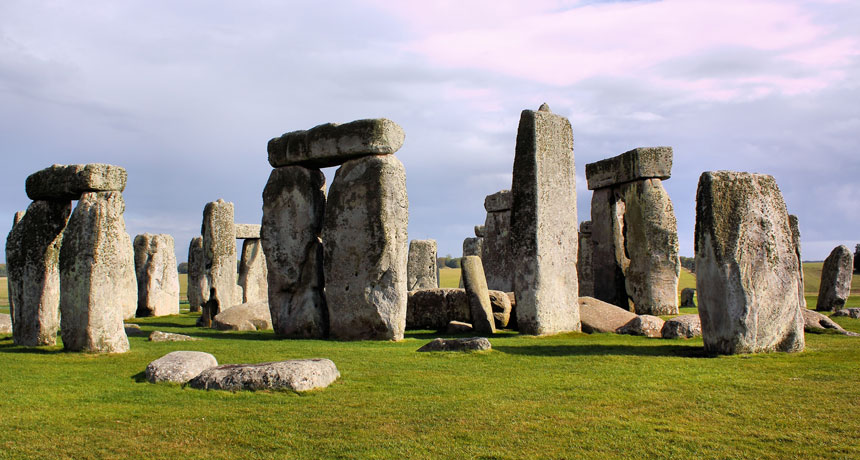Cremated remains hint at who was buried at Stonehenge
Chemical signatures of skull pieces suggest some of the dead came from far away

Stonehenge is a mysterious monument in southern England. Cremated remains were buried there some 5,000 years ago — the last vestiges of people from far away.
AIRWOLFHOUND/WIKIMEDIA COMMONS (CC BY-SA 2.0)
Share this:
- Share via email (Opens in new window) Email
- Click to share on Facebook (Opens in new window) Facebook
- Click to share on X (Opens in new window) X
- Click to share on Pinterest (Opens in new window) Pinterest
- Click to share on Reddit (Opens in new window) Reddit
- Share to Google Classroom (Opens in new window) Google Classroom
- Click to print (Opens in new window) Print
By Bruce Bower
Ancient people moved bodies of the dead from far away to be buried at Stonehenge, a new study finds. The analysis offers the first glimpse of who those people were. Some appeared to have lived more than 200 kilometers (120 miles) away.
Stonehenge is an ancient monument in southern England. It features a ring of massive stones. Underground pits hold human remains. Researchers analyzed some of the remains, which had been cremated and buried around 5,000 to 4,400 years ago.
Some of the rocks that make up Stonehenge came from what is now West Wales. Known as bluestones, these rocks were used in early stages of building the ancient monument. Bluestones are smaller than the massive sandstone boulders that also make up Stonehenge. The new analysis suggests some of the people buried at the site also came from what West Wales.
Ancient societies across southern England and Wales may have been linked. Until now, evidence for those links came from archaeological finds. Still, those links had been “rather shaky,” says Timothy Darvill, who was not involved in the research. The new study, he says, gives more detail about how those ancient societies might have been connected. Darvill is an archaeologist at Bournemouth University in Poole, England.
Signatures in skulls
Before now, scientists had a hard time figuring out where Stonehenge’s cremains came from. In the new study, Christophe Snoeck and his colleagues looked at human skull fragments previously found among the cremated remains at Stonehenge. Snoeck is an archaeologist in Belgium at the Free University of Brussels.

The researchers analyzed two forms (isotopes) of the element strontium in the skulls. Rock formations and soil can vary by region in the ratio of these strontium types. Plants absorb strontium from the soil. When humans and other animals eat plants, they add that strontium into their bones and teeth. The researchers hoped strontium in the skull fragments could help them narrow down where the skulls came from.
When ordinary pieces of bone are buried, they absorb strontium from the soil. But in earlier research, Snoeck found that pieces of cremated bone are different. They hold onto a strontium signal from around the last 10 years of someone’s life.
The researchers have now studied bones from 25 cremated people at Stonehenge. Ten had spent their last decade of their lives in West Wales or nearby, they now report. The rest were locals. The researchers described their findings August 2 in Scientific Reports.
“Our results show that it was not just bluestones but people, or in some cases perhaps just their cremated remains, that came to Stonehenge in its early phases,” says Rick Schulting. He’s an archaeologist at the University of Oxford in England.
Ancient ties
Stonehenge served as a cemetery for at least 500 years. But that was long ago, starting around 5,000 years ago. Between 1919 and 1926, researchers dug up cremains at the site of up to 58 people. Researchers reburied them again in 1935.
Then, in 2008, a team re-excavated cremains from 25 people. Study coauthor Mike Parker Pearson led that team. Pearson is an archaeologist in England at University College London. These remains were the ones analyzed for the new study.
The researchers suspect distant people were cremated before moving their remains to Stonehenge. One hint comes from the carbon in their bones. The scientists looked at levels of two isotopes of carbon. The bones absorbed these isotopes from the burning wood during their cremation. The carbon-isotope signature hints that the wood came from trees in dense forests, such as those in Wales. Trees from more open landscapes, such as those in southern England, have a different ratio of carbon isotopes.
Researchers still don’t know how much contact there was between ancient people in these two regions. One reason: The tooth enamel, which holds a strontium record of childhood diet, is destroyed by cremation. So researchers cannot use strontium to identify where the people buried at Stonehenge had grown up.
For now, researchers know only about the final years of people buried at Stonehenge millennia ago. And their best bet is that nonlocal people spent their final years in western Britain, possibly West Wales, says Alasdair Whittle. He’s an archaeologist at Cardiff University in Wales.
Archaeological finds from that time link people living off Scotland’s northeast coast to people in mainland Britain and probably continental Europe. That makes long-distance contact between western Britain and Stonehenge more likely, Whittle adds.
Archaeologists also have turned up ancient cultural ties between southern England and France’s northwestern Brittany region, Darvill notes. Those connections go back some 5,000 years. That means outsiders could have come to Stonehenge from places other than Wales. Darvill thinks the researchers should also check strontium signatures of cremains at Stonehenge for signs that some might have come from France.







